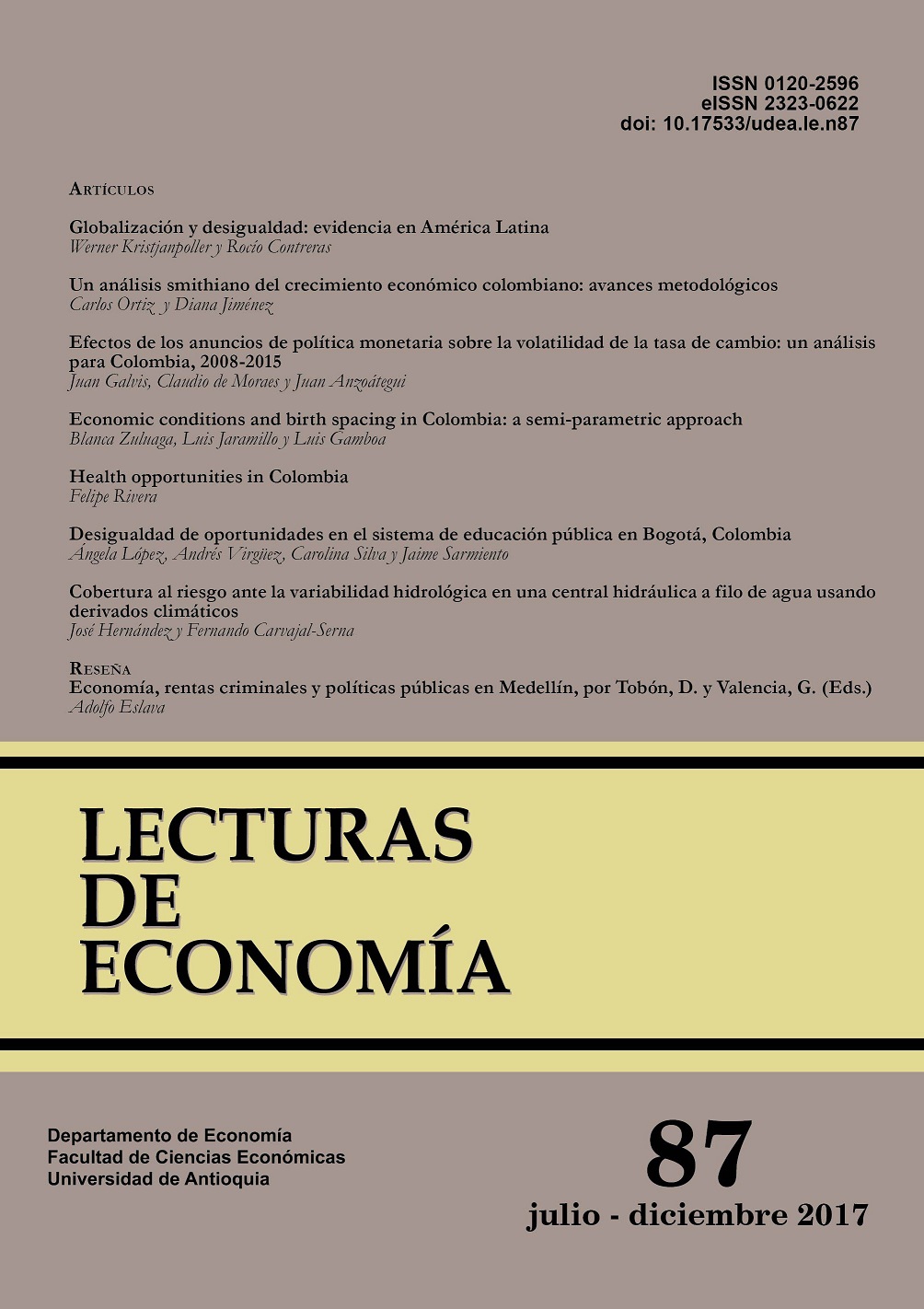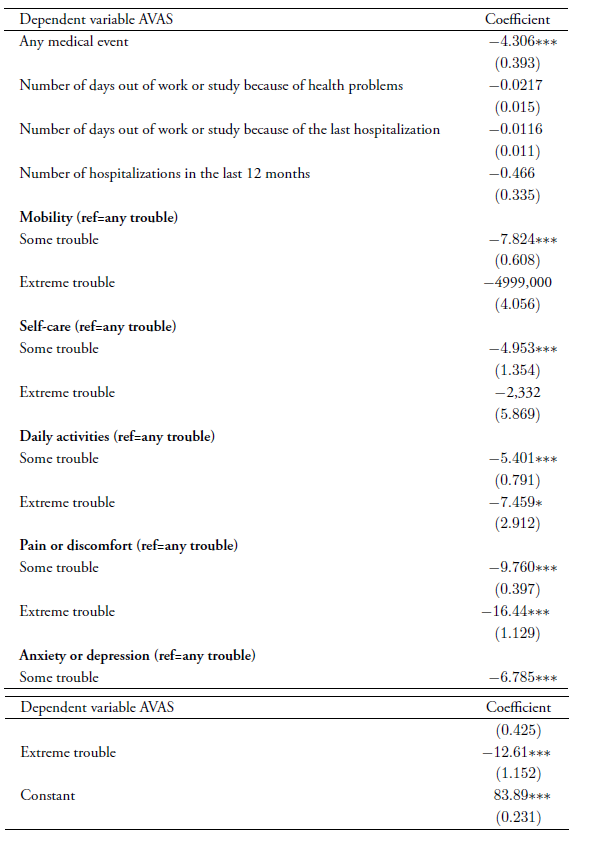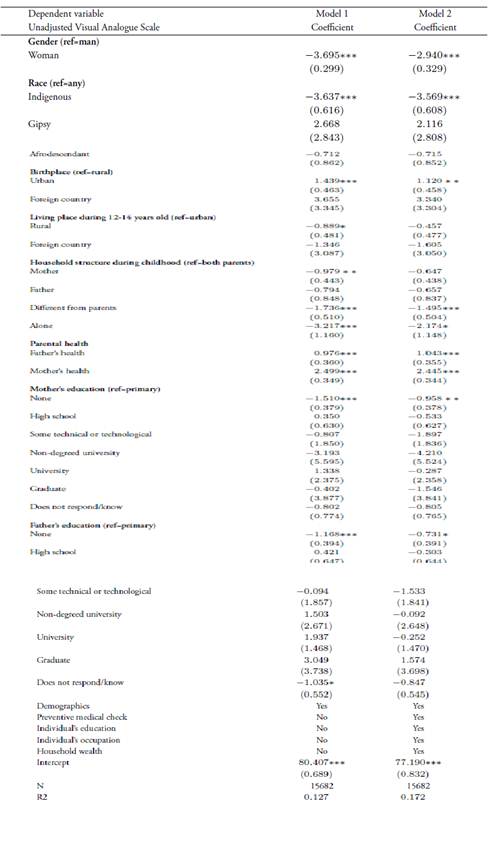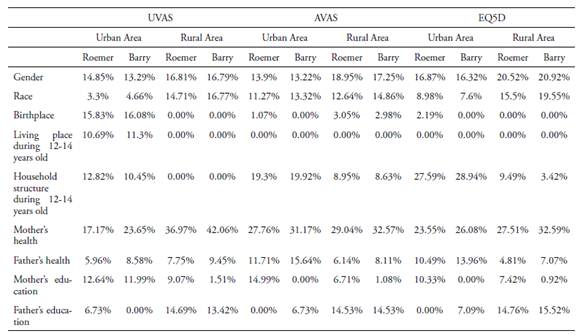Health opportunities in Colombia
DOI:
https://doi.org/10.17533/udea.le.n87a05Keywords:
health, equality of opportunity, circumstances, individual effort, ColombiaAbstract
According to the theory of equality of opportunity, inequality in final outcomes (e.g., monetary income) is mainly caused by two broad characteristics: circumstances and individual effort. Individuals have no control on the former but on the latter. Inequalities in final outcomes caused by circumstances are considered unfair, while those generated by effort are not. In this paper, we calculate the level of unjust inequality in health in Colombia. A preliminary conclusion is that Colombia presents evidence of inequality of opportunities in health, which explains between 30% and 40% of total inequality in self-reported health status. Considering only observable circumstances, mother’s health, household structure through childhood, and gender are individual characteristics that have considerable influence on this type of inequality.
Downloads
References
Acosta, Karina (2014). “La salud en las regiones colombianas: inequidad y morbilidad”, Documentos de Trabajo Sobre Economía Regional, No. 213. Banco de la República.
Allison, Andrew & Foster, James (2004). “Measuring health inequality using qualitative data”, Journal of Health Economics, Vol. 23, No. 3, pp. 505-524.
Anand, Sudhir (2002). “The concern for equity in health”, Journal of Epidemiology and Community Health, Vol. 56, No. 7, pp. 485-487.
Arneson, Richard (1989). “Equality and equal opportunity for welfare”, Philosophical Studies, Vol. 56, No. 1, pp. 77-93.
Arnsperger, Christian (1994). “Envy-freeness and distributive justice”, Journal of Economic Surveys, Vol. 8, No. 2, pp. 155-186.
Balia, Silvia & Jones, Andrew (2011). “Catching the habit: A study of inequality of opportunity in smoking-related mortality”, Journal of the Royal Statistical Society Series A, Vol. 174, No. 1, pp. 175-194.
Barry, Brian (2005). Why Social Justice Matters. Cambridge: Polity Press.
Bernal, Raquel & Cárdenas, Mauricio (2005). “Race and ethnic inequality in health and health care in Colombia”, Working Papers Series, No. 29. Fedesarrollo.
Bernal, Raquel; Cadena, Ximena; Camacho, Adriana; Cárdenas, Juan Camilo; Fergusson, Leopoldo; Ibáñez, Ana María; Rodríguez, Catherine & Peña, Ximena (2014). “Encuesta Longitudinal Colombiana de la Universidad de los Andes- ELCA 2013”, Series Documentos Cede, No. 42. Universidad de Los Andes.
Brazier, John; Ratcliffe, Julie; Tsuchiya, Aki & Salomon, Joshua (2007). Measuring and Valuing Health Benefits for Economic Evaluation. United States: Oxford University Press.
Brunello, Giorgio & Checchi, Daniele (2007). “Does school tracking affect equality of opportunity? New international evidence”, Economic Policy, Vol. 22, No. 52, pp. 781-861.
Camacho, Adriana & Flórez, Cármen Elisa (2012). “Diagnóstico e inequidades de la salud materno-infantil en Colombia: 1990-2010”. In: Bernal Óscar MD & Gutiérrez Catalina (Eds.), La salud en Colombia (pp. 67-80). Bogotá: Universidad de Los Andes.
Case, Anne; Lubotsky, Darren & Paxson, Christina (2002). “Economic status and health in childhood: The origin of the gradient”, American Economic Review, Vol. 92, No. 5, pp. 1308-1334.
Case, Anne; Fertig, Angela & Paxson, Christina (2005). “The lasting impact of childhood health and circumstance”, Journal of Health Economics, Vol. 24, No. 2, pp. 365-389.
Clarke, Philip & Ryan, Chris (2006). “Self-reported health: Reliability and consequences for health inequality measurement”, Health Economics, Vol. 15, No. 6, pp. 645-652.
Cohen, Gerald (1989). “On the Currency of Egalitarian Justice”, Ethics, Vol. 99, No. 4, pp. 906-944.
Crossley, Thomas & Kennedy, Steven (2002). “The reliability of selfassessed health status”, Journal of Health Economics, Vol. 21, No. 4, pp. 643-658.
Dworkin, Ronald (1981a). “What Is equality? Part 1: Equality of welfare”, Philosophy & Public Affairs, Vol. 10, No. 3, pp. 185-246.
Dworkin, Ronald (1981b). “What is equality? Part 2: Equality of resources”, Philosophy & Public Affairs, Vol. 10, No. 4, pp. 283-345.
Fajardo-Gonzalez, Johanna (2016). “Inequality of Opportunity in Adult Health in Colombia”, The Journal of Economic Inequality, Vol. 14, No. 04, pp. 395-416.
Felitti, Vincent; Anda, Robert; Nordenberg, Dale; Williamson, David; Spitz, Allison; Edwards, Valerie; Koss, Mary & Marks, James (1998). “Relationship of childhood abuse and household dysfunction to many of the leading causes of death in adults: The Adverse Childhood Experiences (ACE) Study”, American Journal of Preventive Medicine, Vol. 14, No. 4, pp. 245-258.
Ferreira, Francisco & Gignoux, Jérémie (2011). “The measurement of inequality of opportunity: Theory and an application to Latin America”, Review of Income and Wealth, Vol. 57, No. 4, pp. 622-657.
Fields, Gary (2003). “Accounting for income inequality and its change: A new method, with application to the distribution of earnings in the United States”, In: Polachek Salomon (Ed.), Worker Well-Being and Public Policy (pp. 1-38). United Kindom: Emerald Publishing Limited.
Fleurbaey, Marc (1995). “Equality and responsibility”, European Economic Review, Vol. 39, No. 3, pp. 683-689.
Fleurbaey, Marc (2008). Fairness, responsibility, and welfare. New York: Oxford University Press.
Fleurbaey, Marc & Maniquet, Francois (2011). “Compensation and responsibility”, In: Arrow Kenneth, Sen Amartya & Suzumura Kotaro (Eds.), Handbook of Social Choice and Welfare (Vol. 2, pp. 507-604). Oxford: North-Holland.
Fleurbaey, Marc & Peragine, Vito (2013). “Ex ante versus ex post equality of opportunity”, Economica, Vol. 80, No. 317, pp. 118-130.
Fleurbaey, Marc & Schokkaert, Erik (2009). “Unfair inequalities in health and health care”, Journal of Health Economics, Vol. 28, No. 1, pp. 73-90.
Fleurbaey, Marc & Schokkaert, Erik (2011). “Equity in Health and Health Care”, In: Pauly Mark, Mcguire Thoman & Barros Pedro (Eds.), Handbook of Health Economics (pp. 1003-1092), Vol. 2, Oxford: North-Holland.
Flórez, Cármen Elisa & Soto, Victoria Eugenia (2007). “Evolución de la equidad en el acceso a los servicios y estado de salud de la población colombiana 1990-2005”, Documentos de Trabajo, No. 15. Fundación Corona.
Fresneda, Óscar (2010). “Análisis de desigualdades en el estado de salud percibido”, In: Análisis de la situación de salud en Colombia 2002-2007 (Vol. VI, pp. 61–70). Bogotá: Ministerio de la Protección Social y Universidad de Antioquia, Facultada Nacional de Salud Pública
Idler, Ellen & Benyamini, Yael (1997). “Self-rated health and mortality: a review of twenty-seven community studies”, Journal of Health and Social Behavior, Vol. 38, No. 1, pp. 21-37.
Jusot, Florence; Mage, Sabine & Menendez, Marta (2014). “Inequality of opportunity in health in Indonesia”, Document de Travail, No. 33. Université Paris-Dauphine.
Jusot, Florence; Tubeuf, Sandy & Trannoy, Alain (2010). “Inequality of Opportunities in Health in Europe: Why So Much Difference Across Countries?”, HEDG Working Paper, 10/26. The University of York.
Jusot, Florence; Tubeuf, Sandy & Trannoy, Alain (2013). “Circumstances and efforts: how important is their correlation for the measurement of inequality of opportunity in health?”, Health Economics, Vol. 22, No. 12, pp. 1470-1495.
Kolm, Serge-Christophe (1995). “The economics of social sentiments: the case of envy”, Japanese Economic Review, Vol. 46, No. 1, pp. 63-87.
Kolm, Serge-Christophe (2002a). Justice and equity. Cambridge: MIT Press. Kolm, Serge-Christophe (2002b). Modern theories of Justice. Cambridge: MIT Press.
Lefranc, Arnaud; Pistolesi, Nicolas & Trannoy, Alain (2008). “Inequality of opportunities vs. inequality of outcomes: Are western societies all alike?”, Review of Income and Wealth, Vol. 54, No. 4, pp. 513-546.
Lefranc, Arnaud; Pistolesi, Nicolas & Trannoy, Alain (2009). “Equality of opportunity and luck: Definitions and testable conditions, with an application to income in France”, Journal of Public Economics, Vol. 93, No. 11-12, pp. 1189-1207.
Nielsen, Torben Heien (2015). “The relationship between self-rated health and hospital records”, Health Economics, Vol. 25, No. 4, pp. 497-512.
Pistolesi, Nicolas (2009). “Inequality of opportunity in the land of opportunities, 1968-2001”, The Journal of Economic Inequality, Vol. 7, No. 4, pp. 411-433.
Ramos, Xavier & Van de gaer, Dirk (2015). “Approaches to inequality of opportunity: principles, measures, and evidence”, Journal of Economic Surveys, Vol. 30, No. 5, pp. 885-883.
Roemer, John (1998). Equality of opportunity. United States: Harvard University Press.
Roemer, John; Aaberge, Rolf; Colombino, Ugo; Fritzell, Johan; Jenkins, Stephen; Lefranc, Arnaud... Zubiri, Ignacio (2003). “To what extent do fiscal regimes equalize opportunities for income acquisition among citizens?”, Journal of Public Economics, Vol. 87, No. 3-4, pp. 539-565.
Rosa Dias, Pedro (2009). “Inequality of opportunity in health: evidence from a UK cohort study”, Health Economics, Vol. 18, No. 9, pp. 1057-1074.
Rosa Dias, Pedro & Jones, Andrew (2007). “Giving equality of opportunity a fair innings”, Health Economics, Vol. 16, No. 2, pp. 109-112.
Schütz, Gabriel; Ursprung, Heinrich & Wößmann, Ludger (2008). “Education Policy and Equality of Opportunity”, Kyklos, Vol. 61, No. 2, pp. 279-308.
Sen, Amartya (1979). “Equality of what?”, Tanner Lectures on Human Values. Retrieved from: http://www.ophi.org.uk/wp-content /uploads/Sen-1979_Equality-of-What.pdf (consulted on November 1, 2014).
Sen, Amartya (1985). Commodities and Capabilities. Amsterdam: North-Holland.
Sen, Amartya (2002). “Health: perception versus observation”, BMJ, Vol. 324, No. 7342, pp. 860-861.
Shorrocks, Anthony (1982). “Inequality decomposition by factor components”, Econometrica, Vol. 50, No. 1, pp. 193-211.
Shorrocks, Anthony (1983). “The Impact of Income Components on the Distribution of Family Incomes”, Quarterly Journal of Economics, Vol. 98, No. 2, pp. 311-326.
Strauss, J., & Thomas, D. (2008). “Health over the life course”. In: Schultz Paul & Strauss John, Handbook of Development Economics (Vol. 4, pp. 3375-3473). Oxford: North-Holland.
Szende, Agota; Oppe, Mark & Devlin, Nancy (2007). EQ-5D value sets: inventory, comparative review and user guide. Dordrecht: Springer.
Trannoy, Alain; Tubeuf, Sandy; Jusot, Florence & Devaux, Marion (2010). “Inequality of opportunities in health in France: a first pass”, Health Economics, Vol. 19, No. 8, pp. 921-938.
Varian, Hal (1974). “Equity, envy, and efficiency”, Journal of Economic Theory, Vol. 9, No. 1, pp. 63-91.
Published
How to Cite
Issue
Section
License
Copyright (c) 2017 Andrés Felipe Rivera Triviño

This work is licensed under a Creative Commons Attribution-NonCommercial-ShareAlike 4.0 International License.
This page, by Universidad de Antioquia, is licensed under a Creative Commons Attribution License.
Authors who publish with this journal agree to retain copyright and grant the journal right of first publication, with the article licensed under a Creative Commons Attribution-NonCommercial-ShareAlike License allowing others to share it as long as they acknowledge its authorship and original publication in this journal.
Authors can enter into separate, additional contractual arrangements for the non-exclusive distribution of the journal's published version of the work (e.g., post it to an institutional repository or publish it in a book), provided that these arrangements be not for profit and the journal be acknowledged as the original source of publication.
Authors are permitted and encouraged to post their papers online (e.g., in institutional repositories or on their websites), as it can lead to valuable exchanges as well as greater citation of the published work.







 (
(
 (
(
 . (
. ( (
( (
( (
( (
( (
( (
( (8) (
(8) ( (
( (
( (
( (
( (
(




